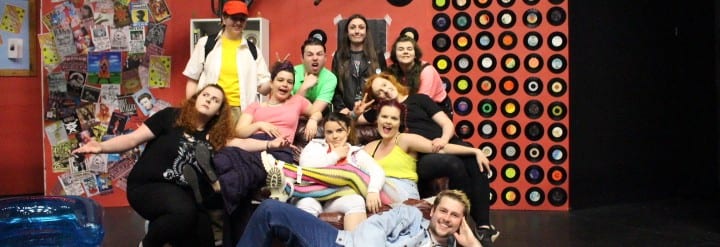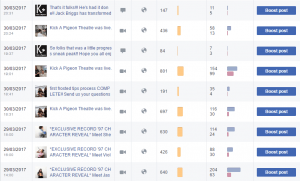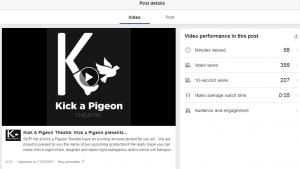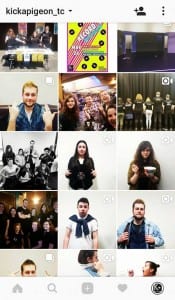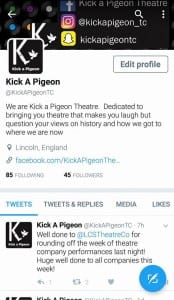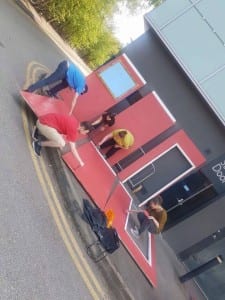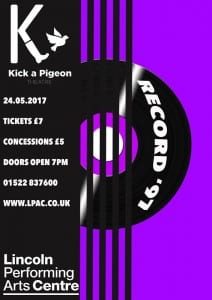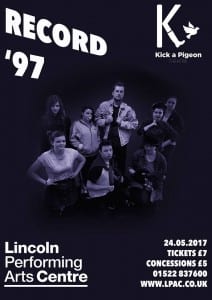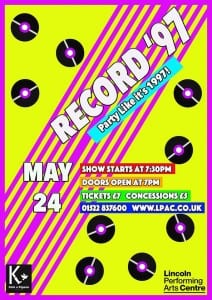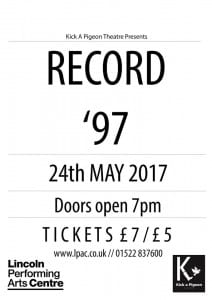As Tuten and Solomon state, “today the Internet is the backbone of our society” (Tuten and Solomon, 2012, 4). It was clear that social media would be our main source of promoting our material and with all the cast falling into our target audience age range, it was a prime opportunity to use the internet to our advantage.
(Kick A Pigeon Theatre, 2017a)
(Kick A Pigeon Theatre, 2017b)
(Kick A Pigeon Theatre, 2017c)
These screenshots are some examples of the activities which took place on the Facebook page. Through the stats we were able to identify the successes of each post and learn from what attracts more audience interaction. Some of the most successful posts included:
The video I made which related to the Frosted Tips campaign when we hit 300 likes:
https://www.youtube.com/watch?v=9ZMHFAEt7fg&feature=youtu.be
Name Reveal: I created a video to reveal that Record 97 was going to be the name of our debut production:
https://www.youtube.com/watch?v=wPURUSH3i-w&feature=youtu.be
And the individual cast introduction boomerang videos:
https://www.youtube.com/watch?v=0k3hpOTHa_o&feature=youtu.be
After gaining a successful amount of audience interaction with our posts, I decided to go that bit further and promoted Kick a Pigeon Theatre on Facebook groups. By targeting Facebook groups specifically for members who are interested in 90s nostalgia, it provided a gateway for me to promote our show and get more interest with how we were involving the 90s in Record ’97.
Twitter and Instagram:
As previously mentioned, Twitter proved difficult to keep up with, especially with the challenge of there being a character restriction which did not able us to promote our show as well as we could. Nevertheless, we used Twitter to tweet and retweets things relevant to our show and used this platform to support fellow theatre companies. Next time, to make Twitter more successful, there could be more than one member controlling the account and we could look into sponsoring a tweet which will promote the information more. Sponsoring or ‘boosting’ a post proved very successful with our Facebook page, so this success can be used on other platforms.
(Kick A Pigeon Theatre, 2017d)
(Kick A Pigeon Theatre, 2017e)
With Record ’97 being a very visually pleased show with an elaborate set, it was prime opportunity to use image dependant social media like Instagram. Throughout the promoting process, this platform was very successful in reaching out to the target audience by using appropriate images and carefully selected hashtags.
Works Cited
Tuten, T.L. and Solomon, M.R. (2012) Social Media Marketing. 2nd Edition. London, California, New Delhi and Singapore: SAGE Publications Ltd.
Kick A Pigeon Theatre. (2017a) FB Stats Image. [image] Lincoln Performing Arts Centre: Kick A Pigeon Theatre.
Kick A Pigeon Theatre. (2017b) FB Stats Image. [image] Lincoln Performing Arts Centre: Kick A Pigeon Theatre.
Kick A Pigeon Theatre. (2017c) FB Stats Image. [image] Lincoln Performing Arts Centre: Kick A Pigeon Theatre.
Kick A Pigeon Theatre. (2017d) Instagram Image. [image] Lincoln Performing Arts Centre: Kick A Pigeon Theatre.
Kick A Pigeon Theatre. (2017e) Twitter Image. [image] Lincoln Performing Arts Centre: Kick A Pigeon Theatre.
